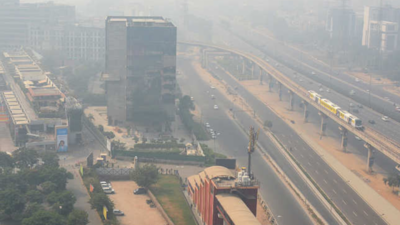Top Searches
- News
- City News
- gurgaon News
- Soon, 4 more air quality monitoring stations for Gurugram
Soon, 4 more air quality monitoring stations for Gurugram

The proposed areas where the monitors are likely to be installed include Golf Course Road (Extension), Badshapur, Pataudi and Farukkhnagar, officials have said.
GURUGRAM: Haryana State Pollution Control Board (HSPCB) is conducting a feasibility survey to install four more continuous ambient air quality monitoring systems (CAAQMS) in Gurugram.
The proposed areas where the monitors are likely to be installed include Golf Course Road (Extension), Badshapur, Pataudi and Farukkhnagar, officials have said.
At present, the city has five air quality index (AQI) measuring stations covering its 732 sq km area. One station is at Gwalpahari, run by the India Meteorological Department. HSPCB-run stations are at Vikas Sadan, Teri Gram, Sector-51 and Manesar for calculating the city’s daily AQI. These stations do not cover all zones of the city and thus do not give an ideal picture during calculation of data.
“There are four locations in Gurugram where we propose to install the automatic air monitors. This will help us gather data and develop a better mitigation plan,” said Kuldeep Singh, regional officer, Gurugram (north), HSPCB.
Sandeep Singh, regional officer, Gurugram (south), HSPCB, said that the expansion will help to understand the airshed of the area. “We do not have data on Pataudi, Farrukhnagar and also the newly built areas which are crucial. We can understand how much stubble burning pollutants are affecting the air shed by studying Pataudi and Farrukhnagar data, while local sources of Golf Course Road (Extension) and Sohna road will be calculated as well.”
As per the Central Pollution Control Board (CPCB) guidelines, cities with 10 to 50 lakh population should have a minimum of five CAAQMS and three manual monitors. This means Gurugram with 15 lakh population (as per Census 2011) should have at least eight air quality monitors. And as per the latest Register General of India 2021 data, the city has a population of 26 lakh.
Experts have welcomed the move. “Expanding a city's air quality monitoring network is essential for understanding how pollution levels vary across the city. But it’s also important to note that monitoring is solely a diagnostic exercise and not a mitigation measure,” said Tanushree Ganguly, programme lead, Council on Energy, Environment and Water (CEEW).
According to the experts, the district needs a mix of both manual and automatic air quality monitoring stations. This is because manual stations provide data of these critical pollutants.
Shubhansh Tiwari, research associate, Amity Center for Air Pollution Control, said, “The existing locations of the five stations are not appropriate and thus a lot of places are still left out of their radar.”
The proposed areas where the monitors are likely to be installed include Golf Course Road (Extension), Badshapur, Pataudi and Farukkhnagar, officials have said.
At present, the city has five air quality index (AQI) measuring stations covering its 732 sq km area. One station is at Gwalpahari, run by the India Meteorological Department. HSPCB-run stations are at Vikas Sadan, Teri Gram, Sector-51 and Manesar for calculating the city’s daily AQI. These stations do not cover all zones of the city and thus do not give an ideal picture during calculation of data.
“There are four locations in Gurugram where we propose to install the automatic air monitors. This will help us gather data and develop a better mitigation plan,” said Kuldeep Singh, regional officer, Gurugram (north), HSPCB.
Sandeep Singh, regional officer, Gurugram (south), HSPCB, said that the expansion will help to understand the airshed of the area. “We do not have data on Pataudi, Farrukhnagar and also the newly built areas which are crucial. We can understand how much stubble burning pollutants are affecting the air shed by studying Pataudi and Farrukhnagar data, while local sources of Golf Course Road (Extension) and Sohna road will be calculated as well.”
As per the Central Pollution Control Board (CPCB) guidelines, cities with 10 to 50 lakh population should have a minimum of five CAAQMS and three manual monitors. This means Gurugram with 15 lakh population (as per Census 2011) should have at least eight air quality monitors. And as per the latest Register General of India 2021 data, the city has a population of 26 lakh.
Experts have welcomed the move. “Expanding a city's air quality monitoring network is essential for understanding how pollution levels vary across the city. But it’s also important to note that monitoring is solely a diagnostic exercise and not a mitigation measure,” said Tanushree Ganguly, programme lead, Council on Energy, Environment and Water (CEEW).
According to the experts, the district needs a mix of both manual and automatic air quality monitoring stations. This is because manual stations provide data of these critical pollutants.
Shubhansh Tiwari, research associate, Amity Center for Air Pollution Control, said, “The existing locations of the five stations are not appropriate and thus a lot of places are still left out of their radar.”
FOLLOW US ON SOCIAL MEDIA
FacebookTwitterInstagramKOO APPYOUTUBE
Start a Conversation
end of article









